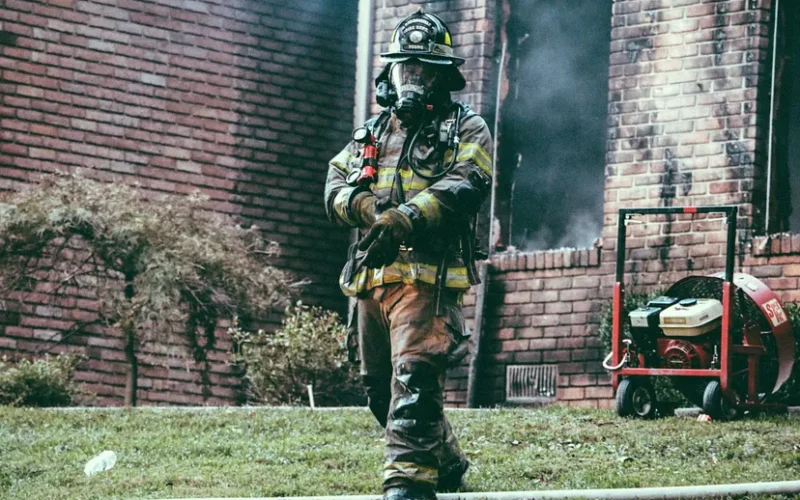Firefighters risk their lives to protect communities, relying heavily on their gear to keep them safe. One significant component in firefighting gear is PFAS (per- and poly-fluoroalkyl substances), which is used for its protective properties.
However, growing concerns about PFAS’s health and environmental impacts are leading to a reevaluation of its role. This article explores whether PFAS is helping or hindering firefighters.
The Role of PFAS in Firefighting Gear
PFAS compounds have been used in firefighting gear for decades, providing resistance to heat, water, and chemicals. These substances enhance the durability and effectiveness of the gear, ensuring that firefighters can operate safely in hazardous environments. Their ability to repel water and oil helps keep the gear dry, reducing the risk of steam burns. This resistance is important for firefighters, who often face extreme conditions.
However, there has been an increasing health concern around the use and safety of these PFAS-based protective gear. According to North Carolina Health News, studies have revealed that as the fire fighting gear ages, the associated risks from PFAS increase. Around 20 different types of PFAS may be present in firefighting gear, which can be hazardous to human health.
Are Firefighter Suits Carcinogenic?
Yes, because they contain PFAS chemicals that can become toxic when exposed to higher temperatures or get older. Since individuals from this department are constantly working under high temperatures, they are at risk of developing cancers through their gear.
Health Concerns Linked to PFAS
Despite their protective benefits, PFAS chemicals have raised significant health concerns. According to studies, PFAS may accumulate over time in the human body and have a detrimental effect on health. Numerous health problems, including cancer, liver damage, and immune system malfunction, have been connected to these substances.
Regular exposure to these substances increases the risk of health issues for firefighters. Studies have found elevated levels of PFAS in the blood of firefighters, suggesting significant exposure through their gear.
A small study was conducted on 18 firefighters from Fall River, Hyannis, and Nantucket in 2022 to examine this. According to Herald News, firefighters have higher amounts of PFAS than common individuals. These higher levels of PFAS in the blood can cause numerous problems, like cancers, birth defects, declining immune health, etc.
Consider the example of PFAS exposure through aqueous film forming form (AFFF) used by firefighters for liquid-fuel-based infernos. According to TorHoerman Law, AFFF has been linked to numerous kinds of cancers, such as:
- Mesothelioma
- Testicular cancer
- Pancreatic cancer
- Bladder cancer
- Breast cancer
- Liver cancer, etc.
When AFFF is dumped into the environment without any precautionary measures, it can even harm other people staying nearby. However, people who have suffered from exposure to PFAS through such actions can take legal procedures. They can sue the people who dumped PFAS and the manufacturers for the exposure.
Through a PFAS lawsuit, the plaintiffs can seek the rightful compensation they deserve. For instance, suppose someone has developed cancer due to the exposure. In that case, the person will have to get medical help and may not be able to continue working at 100%. Seeking medical help and losing wages can both affect the person and their family financially. Thus, they can ask for compensation for those financial and other damages.
What Are the Most Harmful PFAS?
Perfluorooctanoic acid (PFOA) and perfluorooctane sulfonate (PFOS) are the two most well-known PFAS compounds. Following the disclosure of their hidden risks, the Environmental Protection Agency (EPA) put pressure on manufacturers of certain goods to phase them out.
Should PFAS be Used in Firefighting Gear?
The question of whether PFAS should continue to be used in firefighting gear is complex. On one hand, the protective qualities of PFAS are undeniable, and they play a critical role in keeping firefighters safe in dangerous situations. On the other hand, the potential health risks cannot be ignored.
Alternatives to PFAS are being explored, but they must meet the same stringent safety standards to ensure firefighters remain protected. Balancing the immediate safety needs of firefighters with the long-term health risks is a challenging task.
Environmental Impact of PFAS
Both the environment and human health are at risk from PFAS substances. These substances can linger in the environment for years because they are persistent, which means they do not decompose quickly. They put ecosystems and species at danger by contaminating soil, water, and the air.
Firefighting foam, often containing PFAS, has been a significant source of environmental contamination, especially around training sites and areas where large-scale fires have occurred. This widespread contamination has led to calls for stricter regulations and the development of safer alternatives.
A ScienceDirect study shows that North Carolina in the US is one of the worst affected sites for PFAS contamination. The Cape Fear River in North Carolina, measuring around 9300 sq. miles of waterways, provides services to around 5.2 million people. It is amongst the many river bodies that are affected by PFAS contamination.
What Are the Environmental Risks of PFAS?
When PFAS-containing items are spilled or disposed of on the land surface, they have the potential to enter groundwater and surface waterways. PFAS may travel through particular types of ground surfaces with ease, and they can even get into groundwater. These groundwater sources may be utilized for private drinking water wells or public water systems.
Changing Regulatory Landscape Around PFAS-Based Firefighting Gear
Regulations and practices have changed as a result of the increased public knowledge of the risks presented by PFAS. Stricter regulations are being implemented by several nations regarding the use of PFAS in numerous items, including firefighting equipment.
In January 2023, the Department of Defense released new rules with respect to the purchase of PFAS-free firefighting gear. The new rules also mandate airports to follow this regulation on the protective gear used by firefighters. Around 11 states have already put a ban on the sale of fire fighting gear containing PFAS.
This regulatory shift is driving innovation in the industry as companies seek to produce gear that is both effective and safe.
PFAS has played a significant role in firefighting gear, offering protection in dangerous situations. However, the health and environmental risks associated with these chemicals are significant. The firefighting community is at a crossroads, needing to balance immediate safety with long-term health and environmental considerations. As regulations evolve and new alternatives are developed, the hope is that firefighters will have access to safe protective gear
Read More About: Initiatives to Reduce Car Accidents and Fatalities in Atlanta

